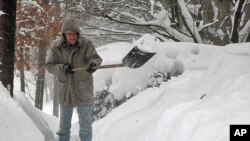Battered residents in the northeastern United States struggled Thursday to recover from back-to-back blizzards that blanketed the region and led to record levels of snowfall in some cities, including Washington D.C.
The federal government was closed for the fourth straight day in Washington and the capital city joined other major metropolitan areas recording their largest total winter snowfalls in history.
The National Weather Service says more than 53 centimeters of new snow fell on Washington during the latest storm.
The region was already buried in up to 90 centimeters of snow from a storm less than a week earlier.
Schools and many businesses in the area remain closed, while hundreds of airline flights were cancelled.
Limited air travel resumed Thursday at airports in Washington, Baltimore, Philadelphia and New York.
Virginia Governor Bob McDonnell called out the National Guard to help people dig out from the storms in hard hit areas outside Washington. "Most of the major interstates [highways] now are in reasonably good shape. We are working through the primaries (roads). We have got additional National Guard that I deployed up there on Saturday, about 500 people and about 40 trucks to help get into some of those neighborhoods for emergency operations," he said.
The blizzards affected tens of millions of people from Virginia up the East Coast to Massachusetts.
The storms were accompanied by wind gusts of up to nearly 90 kilometers per hour.
"There is some melting. They can see some blacktop so they might think that it is safe. But there is still black [difficult to see] ice out here and it is still treacherous," said Tom Flint, a private contractor who is helping plow streets in Northern Virginia.
Washington and the surrounding states of Maryland and Virginia have requested help from the federal government to pay for the massive cleanup.
Washington Mayor Adrian Fenty called in extra equipment to help residents remove enormous amounts of snow. "Backhoes, tractors, everything, we have got a lot coming in so neighbors are going to see that out in their residential streets. We are going to help them dig out because there is just so much snow," he said.
Residents, like this man who lives on Capitol Hill in central Washington, are hoping life will return to normal soon. "It is wonderful just to be able to dig things out, get to work and try and get life back under control," the resident said.
As the day progressed in Washington, temperatures hovered around the freezing mark, but bright sunshine began to melt the snow and improve driving conditions on roads in many suburban communities such as Silver Spring, Maryland. "They are pretty good. They are passable. Most of the lanes of major streets are down to the pavement. They are a little wet, but most all of the lanes are clear," he said.
As exhausted residents longed for a respite from the winter weather, forecasters warned of the possibility of another snow storm on the East Coast early next week.
To observe the road conditions in the Washington DC suburbs up close after the second wave of snow finally came to an end, VOA's David Clements took to the streets again on the morning of February 11, 2010.









